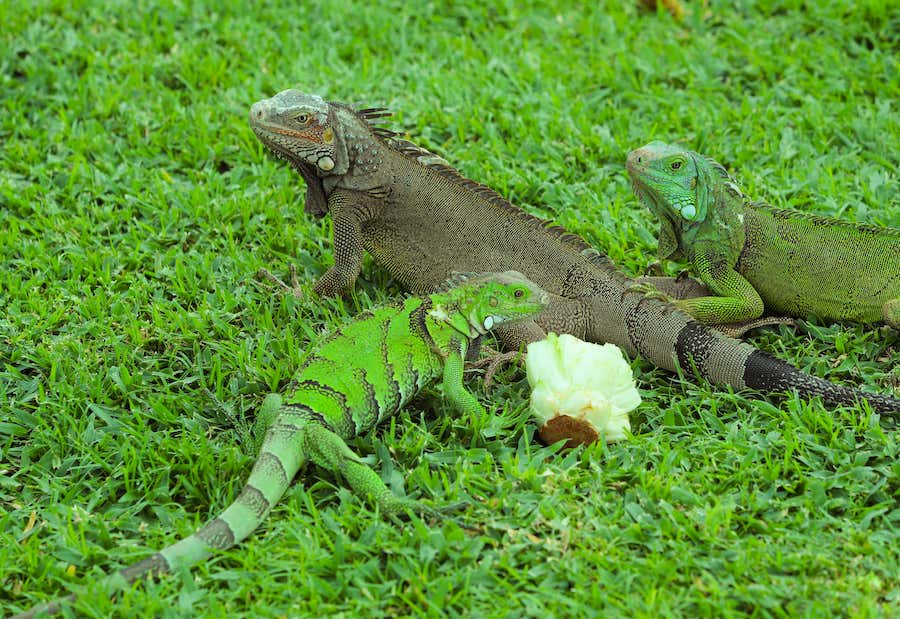Iguanas are fascinating creatures that have become quite popular as pets in recent years. These reptiles are native to Central and South America, but they have also made their way to Florida, where they thrive in the warm and humid climate. One question that many people have about iguanas is where they sleep in Florida.
Iguanas are nocturnal creatures, which means that they are most active at night. During the day, they tend to sleep or bask in the sun to warm up their bodies. When it comes to sleeping, iguanas prefer to find a safe and comfortable spot where they can rest undisturbed. In Florida, iguanas can be found sleeping in a variety of places, depending on the time of year and the availability of suitable sleeping spots.
Iguana Habitats in Florida
Florida is home to several species of iguanas, both native and non-native. These fascinating creatures are found in different habitats, from coastal areas to urban environments. In this section, we will explore some of the most common types of iguanas in Florida, as well as the concerns surrounding invasive species and conservation efforts.
Iguanas are a diverse group of lizards that belong to the family Iguanidae. They are found in different parts of the world, including Central and South America, the Caribbean, and some parts of the United States. In this section, we will discuss two species of iguanas, the Green Iguana and the Lesser Antillean Iguana.
Florida’s warm climate and lush vegetation provide an ideal habitat for Different types of iguanas. These reptiles can be found in a variety of environments, ranging from natural habitats to urban and suburban areas.
Green Iguana
The Green Iguana, also known as the Common Iguana, is one of the most popular types of iguanas in the pet trade. They are native to Central and South America and are commonly found in the rainforests. Green Iguanas are large, herbivorous lizards that can grow up to six feet long. They have a green coloration, which helps them blend in with their surroundings. They also have a dewlap, a flap of skin under their chin, which they use to communicate with other iguanas.
Lesser Antillean Iguana
In Florida, the Green Iguana is the most common type of iguana. They are often found in residential areas, where they can be seen basking in the sun on rooftops or in trees. However, it is important to note that Green Iguanas are not native to Florida and are considered an invasive species. As such, they can cause damage to the local ecosystem and are subject to removal by authorities.
Natural Sleeping Environments
Iguanas are arboreal creatures, meaning they spend most of their time in trees. They prefer to sleep in trees, where they are safe from predators and can bask in the sun during the day. Iguanas are also known to sleep in foliage, such as bushes and shrubs, where they can blend in with their surroundings.
In addition to trees and foliage, iguanas can also be found sleeping on rocks and other natural structures. These provide a stable surface for them to rest on and can help regulate their body temperature.
Urban and Suburban Adaptations
As iguanas have become more common in urban and suburban areas of Florida, they have adapted to sleeping in man-made structures. Common locations where iguanas sleep include roofs, attics, and other elevated areas. They may also sleep on fences, walls, and other structures that provide a secure place to rest.
In some cases, iguanas have even been known to enter homes and sleep in attics or crawl spaces. This can be a problem for homeowners, as iguanas can cause damage to property and may carry diseases.
Overall, iguanas in Florida have adapted to a variety of sleeping environments, both natural and man-made. It is important for homeowners to take steps to prevent iguanas from entering their homes and causing damage.
Seasonal Influences on Sleep
Iguanas are cold-blooded reptiles that are native to tropical regions, including Florida. Their sleeping habits are influenced by seasonal changes in temperature, daylight hours, and food availability. In this section, we will explore how iguanas sleep during the summer and winter months in Florida.
Summer Resting Patterns
During the summer months, iguanas in Florida tend to be more active during the day and rest at night. They often sleep in trees or on branches, using their strong claws to grip onto the bark. Iguanas prefer to sleep in areas that provide shade and protection from the sun. They may also burrow into the ground to escape the heat.
Winter Brumation Spots
In the winter months, iguanas in Florida enter a state of brumation to conserve energy and survive colder temperatures. They typically seek out warm and sheltered areas to sleep, such as burrows, hollow logs, or crevices in rocks. Iguanas may also sleep in groups to conserve body heat.
Factors influencing iguana sleeping habits in different seasons include temperature, humidity, food availability, and daylight hours. Iguanas are ectothermic, which means their body temperature is regulated by the environment around them. During the summer, iguanas need to regulate their body temperature by basking in the sun and cooling off in the shade. In the winter, they need to conserve energy and stay warm to survive.
In conclusion, iguanas in Florida have different sleeping patterns depending on the season. During the summer, they are more active during the day and rest at night, while in the winter, they enter a state of brumation to conserve energy and survive colder temperatures. Factors influencing their sleeping habits include temperature, humidity, food availability, and daylight hours.
Human-Iguana Interactions
Florida is home to a large population of iguanas, and they can often be found in residential areas. As such, human-iguana interactions are common, and it is important for residents to understand the potential risks and concerns associated with these interactions. It is important to understand Iguana behavior so that contact with iguanas is safer for yourself and those around you.
Property Damage Concerns
Iguanas can cause significant damage to property, particularly to landscaping and gardens. They are known to dig burrows and tunnels, which can undermine foundations and cause structural damage. Additionally, iguanas are herbivores and will often feed on plants, flowers, and fruits, causing damage to gardens and landscaping.
Homeowners can take steps to mitigate these risks by installing barriers around their property, such as fences or netting, to prevent iguanas from accessing their gardens and landscaping. Additionally, homeowners can choose to plant iguana-resistant plants, such as cacti or succulents, to deter iguanas from feeding on their property.

Safety and Health Risks
Iguanas can also pose safety and health risks to humans. They carry diseases like salmonella, which can cause serious illness in humans, particularly in children and the elderly. Additionally, iguanas can become aggressive if they feel threatened, and their sharp claws and teeth can cause injury.
To prevent these risks, residents should avoid handling iguanas and should not attempt to capture or remove them from their property. If an iguana is causing a nuisance or posing a threat to human health and safety, residents should contact a licensed wildlife removal professional to safely and humanely remove the animal.
Overall, it is important for residents to be aware of the potential risks and concerns associated with human-iguana interactions in Florida. By taking proactive steps to mitigate these risks, residents can enjoy a safe and healthy living environment alongside these fascinating creatures.
Identifying and Managing Iguana Presence
Iguanas are a common sight in Florida, and while they may be fascinating creatures to observe, they can also cause damage to homes and gardens. Identifying and managing iguana presence is essential to prevent damage and ensure the safety of both humans and iguanas.
Detecting Iguana Nests
Iguanas are known to nest and sleep in areas that provide shelter and warmth. These areas can include trees, bushes, and even homes. To detect iguana nests, look for areas with droppings, shed skin, and partially eaten plants. These can indicate the presence of iguanas and their nesting areas.
Eco-Friendly Deterrence
Safe and eco-friendly practices for iguana removal or deterrence are essential to protect the environment and avoid harming the iguanas. Some effective methods include using motion-activated sprinklers, mesh fencing, and natural repellents such as citrus peels or cayenne pepper. It’s important to avoid using harmful chemicals or traps that can harm the iguanas and other wildlife.
Professional Iguana Control
For severe infestations or situations where iguanas pose a threat to human safety, seeking professional assistance for humane iguana control is recommended. Professional iguana control experts can safely and humanely remove iguanas from homes and gardens, while also providing advice on how to prevent future infestations.
In conclusion, identifying and managing iguana presence is essential to prevent damage and ensure the safety of both humans and iguanas. By detecting iguana nests, using eco-friendly deterrence methods, and seeking professional assistance when necessary, homeowners can protect their homes and gardens while also promoting the well-being of these fascinating creatures.


